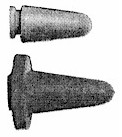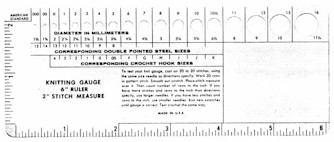Knitting Needles are usually available in three types: Single Pointed Knitting Needles Double Pointed Knitting Needles |
|
 |
Circular knitting needles are used to knit round, seamless sweaters or large flat projects that will not fit on a straight needle. The needle is made of two needle tips connected by a flexible (usually nylon) cord. Before the use of nylon, needles where connected by a metal cording. Aluminum, plastic (nylon), or bamboo are the common materials for these needles. When choosing a circular needle, select a length that is at least 2" shorter than the finished project length or circumference. |
Tape Measure  A tape measure or measuring tape is a ribbon of cloth, plastic, or metal with linear-measure markings, often in both imperial and metric units. Tape measures are typically made of flexible cloth or plastic. Ruler A yardstick is a tool to measure distances up to three feet (a yard). Most yardsticks are flat wooden boards with black markings at regular intervals and metal tips. Many new yardsticks have imperial units markings on one side (three feet with inch and fractional inch) and metric units on the other side (one meter with centimeter and millimeter) on the reverse side. Gauge Ruler or Knitting Needle Gauge |
|
Crochet Hook A crochet hook may be used to pick up dropped stitches, for binding off stitches, or for slip stitching together knitted pieces. Stitch Holder Cable Needle |
|
 |
Point protectors prevent damage to the knitting needle points or tips. The protectors can also keep stitches from sliding off the needle when the work is set aside. |
 |
Bobbins are used in mufti-colored patterns. The different colored yarns are wound on individual bobbins and carried at the back of the work until the color is needed for the pattern. |
 |
Stitch markers are slipped onto the needle between stitch to indicate a change in pattern. |
Stitch and Row Counters Counters< are used to keep track of the row or stitch number worked. |
|
Tapestry needles are used to connect or sew together knitted pieces and to "weave in" yarn ends. A yarn needle is larger than a tapestry needles to accommodate the thickness of yarn. (See How To Thread A Yarn Needle) |
|
 Sewing Scissors - 5"-6" lengths |
 Embroidery Scissors - used for needlework and small cutting jobs |
 |
A yarn swift is used to hold hanks of yarn while it is being wound into balls. |
 |
Quickly create a "pull thread" ball by winding the yarn through this ingenious ball winder. |
Knitting Patterns The dictionary definition of pattern is "anything cut or formed to serve as a guide to cutting or forming objects; as, a dressmaker's pattern." Commercial knitting patterns are developed so the home knitter can create a desired garment or project with no knowledge of pattern drafting. (see Fiber Images™ Knitting Patterns) |
|
copyright © 1997 - 2024, Fiber Images™. ALL RIGHTS RESERVED.





